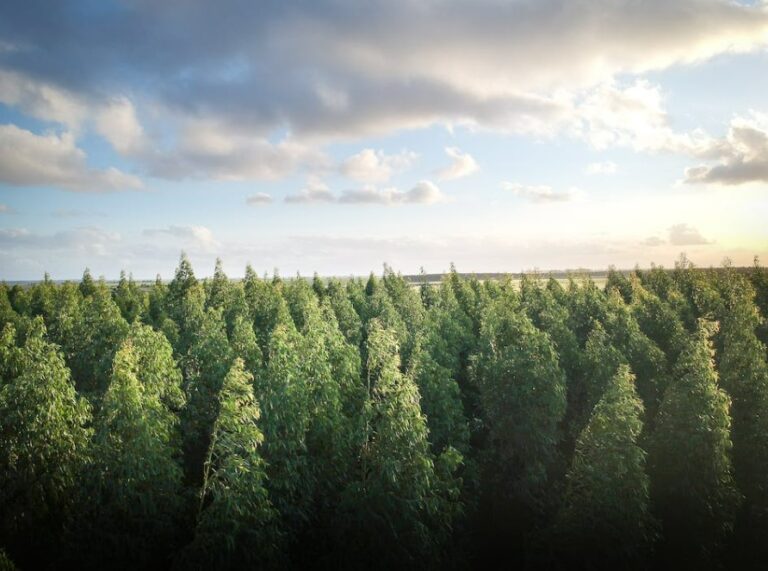Agroforestry, an innovative cultivation system, bridges the gap between forestry and agriculture, fostering resilience, biodiversity, and efficient land use. This blend of trees, shrubs, or bamboo with crops or livestock creates an alternative, profitable, and climate-friendly approach to traditional farming practices.
Unlike conventional farming, Agroforestry offers myriad benefits to farmers and wider society. However, these advantages are dependent on various factors, including system design, farmer objectives, and local conditions. This dynamic method invites us to reenvision our approach to land use, integrating two traditionally separate sectors into a symbiotic relationship.
Table of Contents
Three main types of Agroforestry
At the heart of agroforestry, three main types of systems flourish Agrisilvicultural systems, Silvopastoral systems, and Agrosilvipastoral systems.
Agrisilvicultural systems
Agrisilvicultural systems unify agriculture with silviculture, integrating crops with trees. Think of your local forest garden, where fruit trees stand side-by-side with berry-bearing shrubs and ground herbs. These systems champion diversity, producing an array of edible products and optimizing space utilization.
More extensive applications could include a wheat field bordered by protective hedges or shade trees that yield additional goods, like food or fuelwood. Other examples are alley-cropping, featuring tidy rows of different species, or intercropping, with mixed species growing near each other. Successful Agrisilvicultural projects exist worldwide, including Wakelyns in the UK and Food Forest Haarzuilens in the Netherlands.
Silvopastoral systems
Silvopastoral systems marry trees with pastures or animals. Imagine an orchard thriving on pasture lands frequented by chickens, sheep, or geese. These systems yield additional tree products like fruits or nuts, store CO2, enhance animal living conditions, and foster biodiversity.
They can also include animal fodder production, reducing costs and yielding environmental and soil benefits. Instances of Silvopastoral systems can be found in places like Eichelschwein, Germany, and Investancia, Paraguay.
Agrosilvipastoral systems
Agrosilvipastoral systems embody the complete integration of trees, crops, and animals. For example, bees might be kept for honey production while also pollinating trees and crops.
Home gardens often showcase this system, and it also extends to aquaforestry, where trees are planted around fishponds, with the leaves serving as fodder for fish.
This integration can be combined with crop production, supporting an enriched habitat with diverse species. Agrosilvipastoral systems are available at Apricot Lane in the US and Serra da Estrela in Portugal.
Why Agroforestry?
Our current land-use practices present urgent challenges. Climate change, mass extinction, soil degradation, and spreading deserts signal the dire consequences of our actions. We are eroding our future prosperity, endangering our well-being and the vitality of our planet. Agriculture, responsible for about one-quarter of global greenhouse gas emissions, is a key contributor.
The pervasive use of pesticides threatens biodiversity. A third of the world’s soil is already severely degraded due to unsustainable practices, while the loss of topsoil continues at an alarming rate. The cost of agricultural-related land degradation is staggering, hitting about 490 billion dollars annually.
Agroforestry presents a compelling solution to these challenges. The Sustainable Development Goals (SDGs) and the Paris Agreement call for a transformation in agriculture. We must reduce emissions, store carbon, and halt biodiversity loss, desertification, and land degradation. Amidst these challenges, there’s also the pressure to feed a growing population using increasingly scarce arable land.
Agroforestry can answer this call. It has the potential to produce more food, store CO2, increase biodiversity, and restore degraded land without compromising farmer income. It even supports rural families and creates more livable landscapes for both humans and animals.
Agroforestry contributes to nine out of 17 Sustainable Development Goals (SDGs), underscoring its potential as a key strategy in achieving a sustainable future.
The benefits of Agroforestry
Increased agricultural productivity
Agroforestry serves as a profitable and sustainable approach to agriculture. It uses resources efficiently, from water and sunlight to nutrients, often outpacing the yields of monocultures. For instance, Ernst Götsch’s agroforestry system in Brazil produces twice as much cocoa as a comparable monoculture farm.
Moreover, European agroforestry systems have shown an increase in overall yields by up to 40%. Agroforestry systems can also enhance soil fertility, which reduces the need for costly synthetic fertilizers or pesticides. By lowering investment costs while potentially increasing yields, agroforestry proves to be a highly profitable system.
Reducing hunger and poverty
Agroforestry is a lifeline for farmers in developing countries who rely on their land for survival. By keeping their land productive, agroforestry ensures their food supply and income. Additionally, agroforestry enables farmers to produce diverse fruits and vegetables, combating malnutrition.
Farmers have multiple income sources by diversifying crops, providing a buffer if one crop fails or loses market value. For example, coffee, which can be grown in agroforestry systems, provides an alternative income source, offering resilience against market fluctuations.
Women’s empowerment
Agroforestry can play a significant role in empowering women, especially in developing countries. Women are often involved in food production but typically don’t own the land. With agroforestry’s higher yields, women gain more control over the harvested crops.
Also, as women are usually tasked with collecting firewood, having trees on their own land through agroforestry reduces the time and energy spent on this chore, allowing more time for other activities, including education.
Supporting biodiversity
Agroforestry systems enhance biodiversity, providing food, shelter, and habitat for various species, such as birds and insects, thus strengthening entire ecosystems. Agroforestry practices like integrated crop hedges offer more protection from wind, rain, and predators.
Furthermore, the use of pesticides, which can harm insect populations, is often reduced or eliminated in agroforestry. Agroforestry also nurtures the topsoil, maintaining its health and fertility, which further supports biodiversity.
Enriched soils and water availability
Agroforestry is an antidote to the harmful impacts of conventional agriculture on soil health and productivity.
Trees and plants in agroforestry systems protect the soil from erosion and help to retain water, nurturing soil organisms vital for productive agriculture. This approach to agriculture ensures that soils, which are essential to human well-being, are preserved and improved.
Agroforestry bridges the gap between forestry and agriculture
Agroforestry presents a powerful solution to the environmental, social, and economic challenges facing our world today. From enhancing agricultural productivity and reducing hunger and poverty to empowering women, supporting biodiversity, and enriching soil and water resources, the advantages of agroforestry are extensive.
It offers an innovative approach to harmonizing productivity with ecological health. It’s time to make agroforestry a more mainstream solution in our fight against climate change and to ensure a sustainable future for the planet and its inhabitants.
Read also: What is precision agriculture: an innovative approach that maximizes efficiency and productivity












